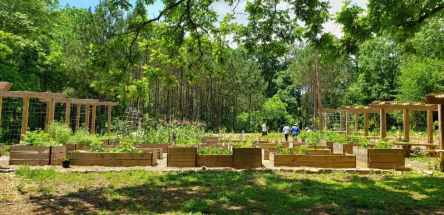Atlanta is developing a new seven acre urban food forest as a new model of city park
and as a way of providing access to healthy food for more citizens. (Photo: Urban Food Forest at Browns Mill)
Food forests are getting increased attention in cities around the nation as one strategy for addressing food deserts — neighborhoods lacking access to grocery stores and healthy food. What is a food forest? Technically, an integrated community of trees and plants that produces edible products.
But the intent is to engage human communities to plan, plant and harvest the produce. In 2018, over 2,800 pounds of artichokes, berries, nuts and vegetables were harvested from Seattle’s six year old, Beacon Food Forest by neighbors coming to take what they needed. And the community invested more than 12,000 volunteer hours in the ongoing project.
Over the past few years, Atlanta has been working towards opening what will become the nation’s largest urban food forest — the seven acre Urban Food Forest at Brown’s Mill. The Brown’s Mill property was once a working farm and local residents remember the owners leaving vegetables along the fence for people to take. The property was going to be subdivided, but in 2016 was acquired by The Conservation Fund as a first step in developing the food forest. The City of Atlanta took over the property recently, with support from the US Forest Service’s Community Forest and Open Space Conservation Program.
The Brown’s Mill Food Forest is planned to have a wide range of fruit and nut trees, berries, more traditional community garden space, walking trails and more. This is part of a significant ramp up in the urban agriculture scene in Atlanta — where there are now 11 farms, 49 orchards, and 189 community gardens in city limits, plus an Urban Agriculture Director working for the city to coordinate long-term goals for the local food economy. There’s also an annual AgLanta Eats local food festival and an AgLanta Conference, both of which engage the local urban food producing community.
Over the past few decades, the separation between many urban residents, the farmers who grow food nearby, and the land conservation programs that protect that farmland has grown. Perhaps food forests are one more way of rebuilding the connections, by growing some of the produce right in the neighborhood.
Lightning Update is a regular communication of the Chesapeake Conservation Partnership. Any opinions expressed are those of the authors and do not necessarily reflect positions of the Partnership or member organizations.
To share a success story, news, or important event, send your information to:
Support for the Chesapeake Conservation Partnership is provided by:
National Park Service Chesapeake
EPA Chesapeake Bay Program
USDA Forest Service
Pennsylvania Department of Conservation & Natural Resources
Maryland Department of Natural Resources
Virginia Outdoors Foundation
US Fish & Wildlife Service
Chesapeake Conservancy
The Chesapeake Conservation Partnership is co-convened by:




